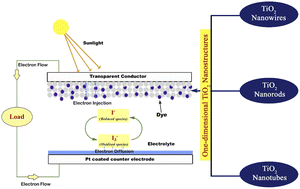Recent progress in one dimensional TiO2 nanomaterials as photoanodes in dye-sensitized solar cells
Abstract
Exploiting the vast possibilities of crystal and electronic structural modifications in TiO2 based nanomaterials creatively attracted the scientific community to various energy applications. A dye sensitised solar cell, which converts photons into electricity, is considered a viable solution for the generation of electricity. TiO2 nanomaterials were well accepted as photoanode materials in dye-sensitized solar cells, and possess non-toxicity, high surface area, high electron transport rates, fine tuneable band gap, high resistance to photo corrosion and optimum pore size for better diffusion of dye and electrolyte. This review focuses on various aspects of TiO2 nanomaterials as photoanodes in dye-sensitized solar cells. TiO2 photoanode modification via doping and morphological variations were discussed in detail. The impact of various morphologies on the design of TiO2 photoanodes was particularly stressed.

- This article is part of the themed collection: Recent Review Articles


 Please wait while we load your content...
Please wait while we load your content...